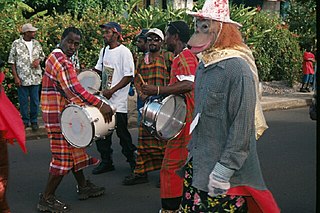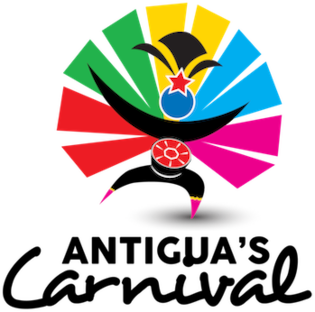The music of Trinidad and Tobago is best known for its calypso music, soca music, chutney music, and steelpan. Calypso's internationally noted performances in the 1950s from native artists such as Lord Melody, Lord Kitchener and Mighty Sparrow. The art form was most popularised at that time by Harry Belafonte. Along with folk songs and African- and Indian-based classical forms, cross-cultural interactions have produced other indigenous forms of music including soca, rapso, parang, chutney, and other derivative and fusion styles. There are also local communities which practice and experiment with international classical and pop music, often fusing them with local steelpan instruments.

The music of Dominica includes a variety of genres including all the popular genres of the world. Popular music is widespread, with a number of native Dominican performers gaining national fame in imported genres such as calypso, reggae, soca, kompa, zouk and rock and roll. Dominica's own popular music industry has created a form called bouyon, which combines elements from several styles and has achieved a wide fanbase in Dominica. Groups include WCK, Native musicians in various forms, such as reggae, kadans (Ophelia Marie, and calypso, have also become stars at home and abroad.
J'ouvert or Jour ouvert is a traditional festival known as "break day" or the unofficial start of Carnival, which takes place on the Monday before Ash Wednesday. The festival, with origins in Trinidad, traditionally begins at 2 a.m. and continues until mid-morning on Monday. J'Ouvert revellers cover their bodies in coloured paints, mud, pitch oil, dress as blue or red devils to dance the streets as an expression of liberation from the constraints of the past and in celebration of the ancestors who have gone before them. Other neighbouring islands, and in areas where Caribbean people have immigrated, celebrate J'ouvert before the official start of Carnival Mas, where the more elaborate costumes are on display and danced through the city streets.

The Toronto Caribbean Carnival, formerly and affectionately known as Caribana, is a festival of Caribbean culture and traditions held each summer in the city of Toronto, Ontario, Canada. It is a pan-Caribbean Carnival event and has been billed as North America's largest Festival, frequented by over 1.3 million tourists each year for the festival's Grand Parade and an overall attendance of 2.3 million.

The Trinidad and Tobago Carnival is an annual event held on the Monday and Tuesday before Ash Wednesday in Trinidad and Tobago. This event is well known for participants' colorful costumes and exuberant celebrations. There are numerous cultural events such as "band launch fetes" running in the lead up to the street parade on Carnival Monday and Tuesday. It is said that if the islanders are not celebrating it, then they are preparing for it, while reminiscing about the past year's festival. Traditionally, the festival is associated with calypso music, with its origins formulated in the midst of hardship for enslaved West and Central Africans; however, recently Soca music has replaced calypso as the most celebrated type of music. Costumes, stick-fighting and limbo competitions are also important components of the festival.
The Burrokeet is a "donkey-man" character traditionally portrayed in Trinidad and Tobago Carnival. The name derives from the Spanish word burroquito, the character's costume being constructed so as to give the illusion of a dancer riding a small burro or donkey. This masquerade was brought to Trinidad by Venezuelan settlers.
The Canboulay riots were a series of disturbances in the British colony of Trinidad in 1881. The riots came about in response to efforts by the colonial police to restrict aspects of the island's annual Carnival festival. In Port of Spain, San Fernando and Princes Town, angered Trinidadians rioted in response to the actions of the police; several people were killed as a result of the riots. Canboulay music forms an important part the musical traditions of Trinidad. The "chantwell" or chantuelle who was also an integral part of the celebrations was the forerunner of the calypsonian and later soca music.
The culture of Trinidad and Tobago reflects the influence of Indian-South Asian, African, Indigenous, European, Chinese, North American, Latino, and Arab cultures. The histories of Trinidad and Tobago are different. There are differences in the cultural influences which have shaped each island. Trinidad and Tobago is an English-speaking country with strong links to the United Kingdom.

The culture of Dominica is formed by the inhabitants of the Commonwealth of Dominica. Dominica is home to a wide range of people. Although it was historically occupied by several native tribes, it was the Taíno and Island Caribs (Kalinago) tribes that remained by the time European settlers reached the island. "Massacre" is a name of a river dedicated to the murders of the native villagers by both French and British settlers, because the river "ran red with blood for days." Each claimed the island and imported slaves from Africa. The remaining Caribs now live on a 3,700-acre (15 km2) Carib Territory on the east coast of the island. They elect their own chief.

The Antiguan Carnival is a celebration of the emancipation of slavery in the country held annually from the end of July to the first Tuesday in August. The most important day is that of the j'ouvert, in which brass and steel bands perform for much of the island's population. Barbuda's Carnival, held in June, is known as Caribana. The Antiguan and Barbudan Carnivals replaced the Old Time Christmas Festival in 1957, with hopes of inspiring tourism in Antigua and Barbuda. Some elements of the Christmas Festival remain in the modern Carnival celebrations.
Batabano is the name of the Caribbean Carnival held in the Cayman Islands. The festival takes place annually during the first week of May in George Town. Batabano is a time for people of all different descents to gather with a common interest and celebrate community spirit. The Cayman Islands are home to over 100 different nationalities, all brought together and embraced by the festival. It is a cultural celebration filled with music, dance, and elaborate costumes that reflect the landscapes, heritage, and culture. International interest is growing in the Batabano celebrations, despite only having existed for about 30 years.

As an overseas department of France, Martinique's culture is French and Caribbean. Its former capital, Saint-Pierre, was often referred to as the Paris of the Lesser Antilles. The official language is French, although many Martinicans speak a Creole patois. Based in French, Martinique's Creole also incorporates elements of English, Spanish, Portuguese, and African languages. Originally passed down through oral storytelling traditions, it continues to be used more often in speech than in writing.
Chanté mas and Lapo kabrit is a form of Carnival music of Dominica. It is performed by masquerading partygoers in a two-day parade, with a lead vocalist (chantwèl), who is followed by the responsorial chorus (lavwa), with drummers and dancers dancing backwards in front of the drummer on a tambou lélé. The Carnival has African and French roots and is otherwise known as Mas Dominik, the most original Carnival in the Caribbean.
Michael Curry is an American production designer who lives in Portland, Oregon. He is also the owner and President of Michael Curry Design Inc. in Scappoose, Oregon, which was started in 1986.

Brian Mac Farlane is a Trinidadian Carnival artist, known as a "Mas' Man" in Trinidad and Tobago.
Cariwest is an annual non-profit three-day Caribbean Arts Festival that takes place annually in the second weekend of August in the heart of downtown Edmonton, Alberta. Cariwest and its surrounding events attract more than 60,000 people each year. The festival gives the attendees a chance to enjoy Caribbean culture.
Leslie Stephen "Teacher" Palmer,, is a Trinidadian community activist, writer and teacher, who migrated in the 1960s to the UK, where he became involved in music and the arts in West London. He is credited with developing a successful template for the Notting Hill Carnival, of which he was director from 1973 to 1975, during which time he "completely revolutionised the event and transformed its structure and content almost beyond recognition." He is also known by the name of "The Wounded Soldier" as a kaisonian.
Yao Ramesar is a Trinidadian and Tobagonian film director and screenwriter.






